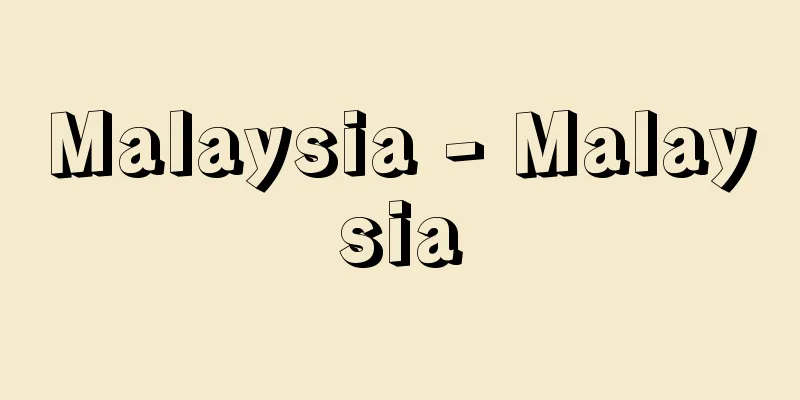Malaysia - Malaysia

|
A constitutional monarchy in Southeast Asia. It is a federal state consisting of mainland Malaysia in the southern part of the Malay Peninsula and the states of Sabah and Sarawak on the northern coast of Borneo. Prior to 1963, the country was part of the Federation of Malaya, centered on the southern part of the Malay Peninsula (Malaya). Its area is 329,758 square kilometers, equivalent to about 87% of Japan's population. Its population is 26,572,000 (2007), of which about 80% live in mainland Malaysia. Its capital is Kuala Lumpur. The stripes and 14 stars on the flag represent the 14 states at the time of Malaysia's founding, but after Singapore's seceding, they represent the unification of the 13 states and the federal government. The crescent moon and star also symbolize Islam, the state religion. [Atsuhiko Bekki and Michiko Kayo] NatureThe Malay Peninsula is generally mountainous, with the Central Mountain Range running north to south in the center. The East and West Banjaran Ranges run parallel to this range, with Mount Tahan (2,189 meters), the highest peak on the peninsula, rising in the East Banjaran Range. The mountains are steep in the north, but gradually lower as you go south, and the southern end is marked by a peneplain. On the east and west of the mountains are the foothills, coastal plains, and coastal marshes with dense mangroves, which are almost symmetrically arranged. Geologically, the mountains are made up of granite, sandstone, limestone, etc., and the granite mountains contain abundant tin ore, making the country the world's largest producer of tin ore, but this position is gradually declining. The main rivers are the Kelantan River, Terengganu River, and Pahang River on the east bank, and the Perak River, Selangor River, and Muir River on the west bank. All of them have short courses but abundant water and meander through the dense forest. The climate is typical of tropical rainforest, hot and humid. The average annual temperature in Kuala Lumpur is 27.0°C, and the annual precipitation is 2,389.8 mm. Precipitation is averaged throughout the months, but the east bank receives the most rain during the northeast monsoon season (November to February). In Sarawak, Borneo, a wide lowland spreads from the coast, through which meandering rivers such as the Rajang and Rupar. Behind it, however, the terrain gradually rises and transitions into the mountain ranges of Borneo, such as the Kapuas and Ilan. On the other hand, Sabah is mountainous as this mountain range occupies most of the state. Mount Kinabalu (4,094 meters), the highest peak in Borneo, rises in the northwest. Sabah's coast is rich in inlets and inlets, and there are many large bays, especially in the east. The climate is similar to that of the mainland Malay Peninsula, but the amount of rainfall is much higher, reaching 3,900 mm per year in Sarawak. This heavy rainfall, together with high temperatures, means that 70 to 80% of the region is still covered in dense forest. [Atsuhiko Bekki and Michiko Kayo] GeographyIn Malaysia, the degree of development varies greatly from region to region, which is the main reason for the creation of regional characteristics. In the peninsula, there is a significant regional difference between the east and west coasts, with the central mountain range as the dividing line. The population density also shows an extreme difference, with over 80 people per square kilometer along the west coast, while the mountainous area and the east coast have around 10 people per square kilometer. In the past, there was probably no significant regional difference in the distribution of Malays in the peninsula, but in modern times, the west coast was rapidly developed and many Indians and Chinese immigrated there, which caused this difference. The west coast faces the international transportation route of the Straits of Malacca, and so the two major port cities of Penang and Malacca have developed since ancient times. However, until the mid-19th century, the rest of the country was nothing but rice paddy fields in the lowlands. However, with the arrival of the British, two major industries emerged: tin mining and rubber plantations. Tin mining began in the mid-19th century in the Kinta River Valley in Perak and spread south along the coast. Rubber cultivation began at the end of the 19th century and spread along the west coast from Kedah in the north to Johor in the south. Both industries developed thanks to favorable natural conditions, but the presence of good harbors on the west coast was also a major factor in promoting their development. In other words, the harbor made it easy to import foreign ethnic groups as labor and export products from there. Thus, the heart of the country today is formed on the west coast, with cities such as Penang, Ipoh, Kuala Lumpur, Seremban, Malacca, and Kluang. In contrast, the central mountain area is still a less developed area compared to the mainland, although new recreational areas such as the Cameron Highlands and Malay National Park are being opened up. The east coast also receives a lot of rain, has extensive wetlands, and is inconvenient to transport, so development is lagging behind except for a few mineral resource mining areas. However, it can also be said that this is an area where traditional Malay culture is still preserved. The northern coast of Borneo is inevitably even more backward due to its natural conditions, but in recent years, some areas have been partially modernized thanks to the development of oil resources and forestry. [Atsuhiko Bekki and Michiko Kayo] historyToday's Peninsular Malaysia was under the control of the Buddhist kingdom of Srivijaya on the island of Sumatra in the 7th century, and in the 13th century it was ruled by the Hindu kingdom of Majapahit on the island of Java. The Sultanate of Malacca, the predecessor of present-day Malaysia, was founded in the early 15th century by Paramesvara, a member of the Sumatran royal family. The kingdom became wealthy by controlling the Straits of Malacca, a key point for East-West trade, and its capital, Malacca, flourished as a major international city of the time, where many different ethnic groups gathered. It also adopted Islam and the Sultanate system, from which Islam was spread throughout Southeast Asia. However, in 1511, the Portuguese captured Malacca and made it a base for trade with Asia and the spread of Christianity, and in 1641 it was replaced by the Dutch. Thus the Sultanate of Malacca collapsed, but its descendants created small kingdoms throughout the peninsula and maintained Malay traditions. At the end of the 18th century, Britain advanced from India, taking control of Penang Island at the northern entrance of the Straits of Malacca in 1786, then occupying Malacca in 1795, and acquiring Singapore Island at the southern tip in 1819. Penang, Malacca, and Singapore were collectively known as the Straits Settlements, and became a direct colony in 1867. Thereafter, Britain used these three bases as bases to gradually gain control over the small kingdoms inside the peninsula, and in 1909 it also acquired the four northern kingdoms that had been Thai territory. However, even under British rule, the Sultan was not dethroned, and the territories of each small kingdom became state units. Meanwhile, the northern coast of Borneo was formerly under the control of the Sultans of Brunei and the Sulu Islands in the Philippines. In 1841, the British man James Brooke was awarded the vast territory of Sarawak by the Sultan of Brunei in recognition of his achievements in defeating pirates. He established a kingdom, becoming king himself, but in 1888 it became a British protectorate. Sabah, where the British North Borneo Company had obtained development rights, also became a British protectorate in the same year. During World War II, the entire region was occupied by the Japanese army. After the war, it returned to British rule, but a strong resistance movement arose among the Malays, and in 1948 the British established the Federation of Malaya, an autonomous government consisting of Penang, Malacca, and nine other peninsular states. After that, the independence movement rapidly grew, and in 1957 the Federation of Malaya became an independent country and joined the British Commonwealth of Nations. The first Prime Minister, Rahman, also attempted to form a new federation by adding Singapore, Sabah, Sarawak, and Brunei. The main aim of this was that by adding the three regions of Borneo, the Malays would have a numerical superiority over the Chinese, but Brunei remained a protectorate of Britain due to its strategic and resource-rich position. Thus, in 1963, the Federation of Malaysia was born, consisting of the Federation of Malaya, Singapore, Sabah, and Sarawak. However, in 1965, Singapore, which had an overwhelmingly Chinese population, separated and became the Republic of Singapore. [Atsuhiko Bekki and Michiko Kayo] PoliticsMalaysia is a federal state consisting of 11 peninsular states, two states Sabah and Sarawak, and the federal territories (Kuala Lumpur, Labuan, Putrajaya), and is a constitutional monarchy. The head of state, the King, is elected by mutual vote from among the sultans of the nine peninsular states (former Islamic small kingdoms) excluding Penang and Melaka, and serves a five-year term. The current King, Mizan Zainal Abidin of Terengganu, was elected in 2006, and is the 13th King. The National Assembly consists of two houses, the Upper House and the Lower House, but the Constitution gives the Lower House great powers. The Upper House has a capacity of 70 members, of which 26 are elected by two from each state assembly, and the remaining 44 are appointed by the King. The term of office is three years. The Lower House has a capacity of 222 members, elected by direct elections in single-seat constituencies. The term of office is five years. The King appoints the Prime Minister, who has the majority of the confidence of the Lower House, and the Ministers of each ministry are appointed from among the members of both houses based on the Prime Minister's recommendation. After Rahman, the Father of Independence, Razak, the Father of Development, and then Hussein Onn, Mahathir became Prime Minister in 1981. Mahathir maintained his administration for a long time, but at the United Malays National Organization (UMNO) party conference in June 2002, he announced that he would resign from his Prime Minister position and other positions in 2003, and that Deputy Prime Minister Abdullah would be his successor. He stepped down in October 2003, and Abdullah became the new Prime Minister. The government is made up of 21 ministries and agencies, including the Prime Minister's Office. In terms of local administration, the states of Sabah and Sarawak have been given greater autonomy than the states in the peninsula, due to circumstances at the time of Malaysia's founding. Since independence, the most powerful political party has been the United Malays National Organization (UMNO), but since the early 1970s, Chinese and Indian parties have joined it to form the broader National Front (BN, NF), which is in charge of governing as a coalition government. In the March 2004 lower house election, the ruling party, the National Front, won a landslide victory over the opposition coalition, the Alternative Front, and the Democratic Action Party (DAP), winning 199 seats, or 90% of the 219 seats in the lower house (at the time). However, in the March 2008 lower house election, the number of seats won had fallen to 63%. In July 2008, Prime Minister Abdullah announced that he would hand over the prime ministerial duties to Deputy Prime Minister Najib. Since the country's founding, the preferential treatment given to Malays and indigenous peoples, known as the Bumiputra (son of the soil) policy, has been implemented, causing great dissatisfaction among Chinese and Indian residents. In November 2007, about 5,000 Indian residents held a protest demonstration in Kuala Lumpur, clashing with police. In terms of diplomacy, as a member of the British Commonwealth, it has had strong ties with Western countries since independence, but it also advocates non-aligned neutrality and has diplomatic relations with most communist countries. It was also the first country to propose the idea of neutralizing Southeast Asia, and is actively promoting regional cooperation centered on ASEAN (Association of Southeast Asian Nations). The military has a total strength of 109,000, consisting of an 80,000-strong army, a 14,000-strong navy mainly consisting of frigates and missile boats, and an 15,000-strong air force including Skyhawk fighter jets (2007). [Atsuhiko Bekki and Michiko Kayo] Economy and IndustryThe country has been blessed with abundant resources, including natural rubber and tin since before the Second World War, palm oil, which has become increasingly important in recent years, wood, and petroleum, but the economy has depended on the export of these primary products, making it vulnerable to the effects of global economic booms and busts. For this reason, the government has implemented several five-year economic development plans since 1966, actively attracting foreign companies and working to diversify and industrialize production, resulting in continued high growth. Gross domestic product (GDP) in 2007 was $185.6 billion, roughly four times higher than in 1998 ($48 billion). Gross national product (GNP) per capita is $6,685. Agriculture is characterized by the cultivation of natural rubber and palm trees, which are commercial crops, and rice for self-sufficiency. Natural rubber is cultivated on 60% of Malaysia's cultivated land, and the country produces 1,284,000 tons (2006), ranking third in the world. However, in recent years, the cultivated land area has been declining due to the influence of synthetic rubber. Rubber plantations used to be dominated by large plantations run by British and Chinese people, known as estates, but after World War II, the number of small plantations run by Malays increased, and the ratio is now almost equal. Palm, the raw material for palm oil, is a crop whose cultivation area has increased rapidly since the war. Its popularity is due to the fact that its cultivation method is similar to that of natural rubber, and it is often planted together with natural rubber. Currently, palm oil production is 15.88 million tons (2006), and it competes with Indonesia for the top spot in the world. Meanwhile, rice production has traditionally been centered on small-scale Malay farmers, and during the colonial period only met around 30% of demand. After independence, however, the adoption of high-yielding varieties and the expansion of irrigated fields and double-cropping led to a self-sufficiency rate of over 80%. Forestry has seen great development since the war. Logs are exported mainly from Sabah and Sarawak to Japan, where they are an important source of foreign currency, and the timber processing industry is developing in the peninsula. Coastal fishing is thriving, mainly along the east coast of the peninsula. Malaysia's tin production has been declining since peaking in 1972, but it still ranks eighth in the world (2006). Until 1970, petroleum was only produced in small quantities at the Miri oil field in Sarawak, but the development of offshore oil fields in Sabah and Sarawak progressed rapidly and petroleum grew into a major export item. Although the history of industrial development is relatively new, it has grown steadily thanks to the active introduction of foreign capital and the increase in oil production. Various factories have been established in industrial centers such as Penang and Petaling Jaya near Kuala Lumpur, and electrical machinery, transport machinery, and other products are exported. Since the sudden increase in oil exports in 1976, trade has shown a tendency towards an export surplus. In 2007, exports amounted to $76,041 million, while imports were $46,852 million. Exports include electrical and electronic products, chemical products, crude oil, LNG, palm oil, and textile products. Imports include manufacturing equipment, transport equipment, and food products. Top trading partners include the United States, Singapore, Japan, and China. Transportation is well developed in mainland Malaysia. The total length of roads is 98,721 km (2005), 81% of which is paved. The main line of the Malaysian Railways (KTM, formerly the Malayan Railways) starts in Singapore and runs along the west coast to Padang Besar in the northwest, connecting with the State Railway of Thailand (RSR). There is also an east coast line that branches off at Gemas and reaches the northern part of Kelantan state. International air routes are centered on Kuala Lumpur and Penang, and domestic air routes are also well developed. Kuala Lumpur International Airport opened in 1998. Major seaports include Penang, Klang, and Melaka. Meanwhile, roads are still underdeveloped on the north coast of Borneo, except along the coast of Sabah, and there is only 160 km of railway in Sabah. For this reason, rivers are an important means of inland transportation, especially in Sarawak. There are nine airports, including international airports at Kota Kinabalu, Kuching, and Senai. Major seaports are at Kota Kinabalu, Sandakan, Miri, and Kuching. [Atsuhiko Bekki and Michiko Kayo] Society and CultureMalaysia is a typical multi-ethnic country made up of Malays, Chinese, Indians and other indigenous peoples, but the ethnic composition differs greatly between the peninsula and the north coast of Borneo. In the peninsula, Malays make up just over half of the population, mainly in rural areas on the east coast, followed by Chinese, particularly in cities on the west coast, and Indians, concentrated around Penang and Kuala Lumpur, with a small proportion of indigenous peoples. In contrast, in Sabah state on the island of Borneo, indigenous peoples such as Kadazan and Bajau make up the majority, followed by Chinese, with Malays being very few in number. In Sarawak state, the largest group is Dayak, followed by Chinese, with Malays being a minority. Looking at the population as a whole, however, 66% of the population is Malay, about 26% Chinese, about 8% Indian, and the rest other indigenous peoples, Europeans, etc. (2007). Malaysia's complex ethnic composition was formed mainly by the migration of Chinese and Indians following the development of the British colony after the latter half of the 19th century, but the influx of many foreign ethnic groups caused serious social conflicts. These ethnic groups, not only in cities but even in rural areas, concentrated in specific areas and strengthened their unity. In particular, the Chinese have been further divided according to their place of origin, and organizations of people from the same hometown, so-called township brigades, have played an important role in this. These township brigades also became the basis for trade association-like organizations called trade brigades. For example, most Chinese rubber plantation managers are Fujian brigades. Thus, in cities, the same Chinese residential area is further divided into Fujianese residential areas, Cantonese residential areas, and so on. This divided social structure was further linked to the living standards and cultural differences of each ethnic group, leading to the formation of so-called ethnic castes. There was little intermarriage between the ethnic groups, which was the main cause of deepening mutual conflict. In the past, Bumiputera (Malays and other indigenous peoples) held political power and many of them took up jobs such as bureaucrats, soldiers, and police officers, but their incomes were not so high. In contrast, the Chinese almost monopolized commerce and industry, and earned high incomes through various professional occupations. This economic disparity further hindered ethnic harmony. The New Economic Policy (NEP) of 1971 aimed to correct the distribution of wealth between the ethnic groups and eradicate poverty, and implemented comprehensive social policies with 1990 as the tentative target. The Seventh Five-Year Plan of 1996 also stated that the inflow of foreign workers would be restricted and that a shift from labor-intensive to skill- and capital-intensive industries would be promoted to address the labor shortage. For historical reasons, the managers of large tin mines and rubber plantations were traditionally British, but in recent years, the British have been retreating and government-affiliated companies have taken over. Religion is also diverse, reflecting this complex ethnic composition. The constitution stipulates that Islam is the state religion, but individual freedom of religion is guaranteed, so the basic structure is that Malays are Muslim, most Chinese are Buddhist, and most Indians are Hindu. In terms of language, Malay is also the national and official language under the constitution, but Chinese use Chinese and Indians use Tamil as their everyday language. Only 24% of Chinese understand Malay, and the same applies to around 35% of Indians. English is also widely used due to historical reasons, with understanding reaching 30% across Malaysia. The education system consists of six years of primary school, three years of junior high school, two years of senior high school, two years of university preparatory school, and three to six years of university. Although there is no compulsory education system, primary and junior high school education is free, and the primary school attendance rate is high at 96%. Traditionally, education in primary and secondary schools was taught in each ethnic language and English, and university lectures were given in English. However, in order to promote cultural uniformity, the Third Education Plan (1976-80) promoted the use of Malay in all educational courses, and university lectures were entirely taught in Malay by 1981. There are ten public universities, including the University of Malay, the National University, the University of Science, and the University of Agriculture, as well as three private universities. [Atsuhiko Bekki and Michiko Kayo] Relations with JapanThe relationship between Malaysia and Japan has become significantly closer since the end of the Second World War, and Japan is Malaysia's major economic partner. In trade, Japan ranks third with 9.1% (2007) of Malaysia's total exports, and is the top importer with 13% (2007). Malaysia's top exporter is machinery, followed by timber, natural gas, crude oil, palm oil, and fish and shellfish. Imports from Japan are mainly semiconductors and other electronic parts, general machinery and equipment, and steel. Japan's investment in Malaysia is mainly in the industrial sector, with direct investment of 58.1 billion yen in fiscal 2005. Since 1966, Japan has provided yen loans for successive five-year plans in the form of economic cooperation, and some of the projects that have been realized through these loans include the Temenggor Dam in the north of the peninsula and the Johor Shipyard. In terms of technical cooperation, Japan is actively involved in various development studies at the request of the Malaysian government, as well as accepting trainees. The cumulative total of Japan's aid up to 2005 was 12.2 billion yen in grant aid, 969.3 billion yen in loan aid, and 105.1 billion yen in technical cooperation. Prime Minister Mahathir, who held the long-term government from 1981 to 2003, launched the "Look East Policy" in 1981, demonstrating a stance of following Japan (and South Korea) for economic development, sending students and trainees to Japan and Japan also cooperating in accepting them. [Atsuhiko Bekki and Michiko Kayo] "Value Systems in Southeast Asia 4: Malaysia and the Philippines" by Yoshiyuki Hagiwara et al. (1973, Gendai Asia Publishing Association)" ▽ "Malay Culture and Customs" by Takeshi Kawai (1983, Japan Malaysia Association) " ▽ "History of Malaysia" edited by Z.A. Abdul Wahid, translated by Toru Nomura (1983, Yamakawa Publishing)" ▽ "Economic and Social Development of Malaysia" edited by Shigeru Higashikawa (1992, Institute of Developing Economies)" ▽ "Malaysia: The Structure of a Multi-Ethnic Society" edited by Jun Onozawa et al. (1994, Imura Bunka Jigyosha)" ▽ "More About Malaysia" edited by Tsuneo Ayabe et al. (1994, Kobundo) " ▽ "Malaysia" (1998), edited and published by World Economic Information Service" ▽ "Agricultural Development and Agribusiness in Malaysia" by Kazuyuki Iwasa (2005, Horitsu Bunkasha) "Malaysia's Economic Development and the Asian Currency Crisis" by Yuichi Hashimoto (2005, Kokon Shoin) " "Malaysia under the Mahathir Administration" edited by Takashi Torii (2006, Institute of Developing Economies) " "Asia's Economic Development and Financial Systems" edited by Shigeo Teranishi et al. (2008, Toyo Keizai Shinposha) [References] | | | | | | | Kuala | | | | | | | | | | | | | | | [Supplementary material] |"> Malaysia flag ©Shogakukan Illustration/Shogakukan Creative "> Malaysia location map Source: Shogakukan Encyclopedia Nipponica About Encyclopedia Nipponica Information | Legend |
|
東南アジアの立憲君主国。マレー半島南部のマレーシア本土と、ボルネオ島北岸のサバ、サラワク両州からなり連邦制をとる。1963年以前はマレー半島南部(マラヤ)を中心にマラヤ連邦を構成していた。面積は32万9758平方キロメートルで日本の約87%に相当する。人口2657万2000(2007)で、約80%はマレーシア本土に居住する。首都はクアラ・ルンプール。国旗の縞(しま)と星の光の数14は、マレーシア発足当時の14州を示したが、シンガポール離脱後は13州と連邦政府の統一を表している。また三日月と星は国教のイスラム教を象徴する。 [別技篤彦・賀陽美智子] 自然マレー半島部は全体として山がちの地形をなし、中央部には中央山脈が南北に縦走している。またこの山脈に並行して東・西バンジャラン山脈が延び、東バンジャラン山脈中に半島の最高峰タハン山(2189メートル)がそびえる。山地は北部では険しいが、南へいくにしたがってしだいに低くなり、南端では準平原化が著しい。また山地を中心にその東西には山麓(さんろく)部、海岸平野部、マングローブの密生する海岸低湿地がほぼ対称的に並ぶ。なお地質的に山地は花崗(かこう)岩、砂岩、石灰岩などからなり、花崗岩山地には豊富な錫(すず)鉱が埋蔵され、この国を世界最大の錫鉱の生産国としてきたが、その地位は徐々に低下してきている。 河川は東岸に注ぐケランタン川、トレンガヌ川、パハン川、西岸に注ぐペラク川、セランゴール川、ミューア川などがおもなものである。いずれも流路は短いが水量は豊富で、密林中を蛇行する。気候は典型的な熱帯雨林型で高温多湿である。クアラ・ルンプールの年平均気温は27.0℃、年降水量は2389.8ミリメートルに達する。降水量は各月にわたって平均化されているが、東岸は北東モンスーン季(11月~2月)に多い。 ボルネオ島のサラワク州では、海岸から幅広い低湿地帯が広がり、そこをラジャン、ルパルなどの河川が蛇行している。しかしその背後で地形はしだいに高度を増し、カプアス、イランなどボルネオ島の脊梁(せきりょう)山脈へと移行していく。一方サバ州は、この脊梁山脈が州の大半を占めるため、全体が山がちである。北西にはボルネオ島最高峰のキナバル山(4094メートル)がそびえている。またサバ州の海岸は出入りに富み、とくに東部には大きい湾が多い。気候は本土のマレー半島部と類似するが、降水量はいっそう多くなり、サラワク州では年間3900ミリメートルにも及ぶ。この多量の降雨は高温とともに、この地方全体のなお70~80%が密林に覆われる状態を生んでいる。 [別技篤彦・賀陽美智子] 地誌マレーシアでは地域により開発度が著しく異なり、それが地域的特色を生み出す主因となっている。半島部では中央山地を境として東西両海岸の地域差が著しい。人口密度も西海岸一帯が1平方キロメートルにつき80人以上であるのに、山地や東海岸地方は10人前後という極端な差異を示している。古くは半島におけるマレー人の分布にはさしたる地域差はなかったと思われるが、近代に入って西海岸が急速に開発され、多数のインド人、中国人が移住してきたことでこの差が生じた。西海岸はマラッカ海峡という国際的交通路に面しているため、古くからペナン、マラッカの二大港湾都市が発達していた。しかし19世紀中ごろまで、その他の地域は低地に水田地帯がみられるにすぎなかった。ところがイギリスの進出とともに、錫(すず)の採掘とゴム園の経営という二大産業がおこった。 錫採掘は19世紀中ごろから、ペラク州のキンタ河谷から始まり、海岸伝いに南へと広がった。またゴム栽培は19世紀末から開始され、北はケダー州から南はジョホール州に至る西岸一帯に広がった。いずれの産業も自然的条件に恵まれて発展したのであるが、西海岸に良港が備わっていたことも、発展を促す大きな要因となった。すなわち、港から労働力として外来民族を移入しやすく、生産物をそこから輸出しやすいという条件が幸いしたのである。こうして今日では西海岸にペナン、イポー、クアラ・ルンプール、セレンバン、マラッカ、クルアンなど諸都市が連なる国の心臓部が形成されている。これに対して中央の山地帯にはカメロン高原、マレー国立公園などの新たなレクリエーション地域が開かれつつあるものの、依然として本土の後進地域である。また東海岸一帯は雨量も多く湿地帯も広く、加えて交通が不便なため、若干の鉱物資源の採掘地を除けば開発が遅れている。しかし、それだけに伝統的マレー文化が、いまなお保たれている地域といえよう。 ボルネオ島北岸部は、自然的条件などから、さらに後進性は免れない。しかし近年、石油資源や林業の開発によって、部分的に近代化が進んでいる所もある。 [別技篤彦・賀陽美智子] 歴史今日のマレーシア半島部は、7世紀ごろスマトラ島の仏教国シュリービジャヤの支配下に置かれ、13世紀にはジャワ島のヒンドゥー教国マジャパヒトに支配された。現在のマレーシアの母体であるマラッカ王国は、15世紀初頭、スマトラ島の王族パラメシュバラによって建国された。この王国は東西貿易の要衝マラッカ海峡を抑えて富裕な国となり、王都マラッカは多様な民族が集まる当時の一大国際都市として栄えた。またイスラム教とスルタン制を採用し、ここから東南アジア各地にイスラム教が伝えられた。しかし、1511年ポルトガルがマラッカを攻略して、ここをアジア貿易とキリスト教普及の基地とし、ついで1641年オランダがこれにかわった。こうしてマラッカ王国は崩壊したが、王国の後裔(こうえい)は半島内部各地に小王国をつくり、マレー的伝統を保った。 18世紀末になるとイギリスがインドから進出し、1786年マラッカ海峡北口のペナン島を抑え、続いて1795年マラッカを占領、さらに1819年南端のシンガポール島を手に入れた。ペナン、マラッカ、シンガポールはまとめて海峡植民地とよばれ、1867年直轄植民地となった。その後イギリスはこの3基地を拠点にしだいに半島内部の各小王国も支配するに至り、1909年にはタイ領となっていた北部の4王国も獲得した。しかしイギリスの統治下でもスルタンは廃位されず、また各小国の領域が州の単位となった。 一方ボルネオ島北岸部は、もとブルネイとフィリピンのスル諸島のスルタンの支配地域であった。1841年イギリス人ジェームズ・ブルークは海賊を討伐した功績によりブルネイのスルタンから広大なサラワクを与えられた。彼は自ら王となって王国を建てたが、1888年イギリスの保護国となった。またサバはイギリス北ボルネオ会社が開発権を得た所であるが、これも同年イギリスの保護領となった。 第二次世界大戦中この地域は全域が日本軍に占領された。戦後ふたたびイギリスの統治下に戻ったが、マレー人の強い抵抗運動が起こり、1948年イギリスはペナン、マラッカと半島部9州よりなるマラヤ連邦自治政府を発足させた。以後独立運動は急速に高まり、1957年マラヤ連邦はイギリス連邦加盟の独立国となった。 初代首相のラーマンはさらにシンガポール、サバ、サラワク、ブルネイも加えて新たな連邦を結成しようと試みた。これは、ボルネオの3地域を加えればマレー人が中国系に数的に優越することを主眼としていたが、ブルネイは戦略的、資源的立場からイギリスがその保護国にとどめた。こうして1963年マラヤ連邦、シンガポール、サバ、サラワクからなるマレーシア連邦が誕生した。しかし、1965年、中国系が圧倒的に多いシンガポールは分離独立し、シンガポール共和国となった。 [別技篤彦・賀陽美智子] 政治マレーシアは半島部11州とサバ、サラワク2州および連邦直轄区(クアラ・ルンプール、ラブアン、プトラジャヤ)とからなる連邦国家で、立憲君主制をとる。国家元首の国王はペナン、マラッカを除く半島部9州(かつてのイスラム小王国)のスルタンのなかから互選で決定され、任期は5年である。現在の国王はトレンガヌ州のミザン・ザイナル・アビディンで2006年選出された。13代目になる。 国会は上下二院からなるが、憲法上、下院に大きな権限が与えられている。上院は定員70で、そのうち26名は各州議会から2人ずつ選出され、残り44名は国王の任命で選ばれる。任期は3年。下院は定員222で、小選挙区制の直接選挙で選ばれる。任期は5年。首相は、下院で多数の信任を得ている議員が国王より任命され、各省大臣は首相の勧告に基づいて上下両院議員中から任命される。独立の父ラーマン、開発の父ラザク、その後のフセイン・オンを経て1981年からはマハティールが首相となった。マハティールは長期にわたって政権を維持したが、2002年6月の統一マレー国民組織(UMNO)の党大会において2003年に首相職等を辞任し、後継を副首相のアブドラ(アブドゥラ)にすると発表、2003年10月退任、新首相にアブドラが就任した。 政府は総理府のほか21省よりなる。地方行政では、サバ、サラワク両州がマレーシア発足当時の事情もあって半島部の州よりも強い自治権を与えられている。政党は、独立以来マレー人系政党の統一マレー国民組織(UMNO)がもっとも強かったが、1970年代初めからは中国系、インド系の政党もこれに加わって広範な国民戦線(BN、NF)を組織し、連立的与党として政権を担当している。2004年3月の下院選挙で与党の国民戦線は野党連合オルタナティブ戦線や民主行動党(DAP)などに圧勝して下院定数219議席(当時)のうち90%の199議席を獲得した。しかし、2008年3月に行われた下院選挙では獲得議席は63%まで減少した。2008年7月、首相のアブドラは副首相のナジブに首相職を移譲すると発表している。 建国以来ブミプトラ(土地の子)政策とよばれるマレー人・先住民族優遇政策がとられているため、中国系住民やインド系住民の不満は大きい。2007年11月にはインド系住民約5000人がクアラ・ルンプールで抗議デモを行い警官隊と衝突した。 外交面ではイギリス連邦の一員として独立以来西側諸国との連携が強いが、非同盟中立主義を掲げ、ほとんどの共産圏諸国とも国交をもった。また東南アジアの中立化構想を最初に提唱した国でもあり、ASEAN(アセアン)(東南アジア諸国連合)を中心とした地域内協力を積極的に推進している。 軍隊は総兵力10万9000人で、8万人の陸軍、フリゲート艦、ミサイル艇などを主とする兵力1万4000人の海軍、スカイホーク戦闘機などを有する兵力1万5000人の空軍からなる(2007)。 [別技篤彦・賀陽美智子] 経済・産業第二次世界大戦前からの天然ゴム、錫(すず)、近年重要性を増してきたパーム油(やし油)、木材、石油など豊富な資源に恵まれているが、経済はこれら一次産品の輸出に依存してきたため、世界の好不況の影響を受けやすかった。このため政府は1966年より数次にわたり経済発展五か年計画を実施、外国企業の積極的誘致、生産物の多角化と工業化に努めて高度成長を続けてきた。2007年の国内総生産(GDP)は1856億ドルと、1998年(480億ドル)のおよそ4倍になっている。1人当り国民総生産(GNP)は6685ドルとなっている。 農業は、商品作物の天然ゴム、パーム(アブラヤシ)栽培と自給用の米作で特徴づけられる。天然ゴムはマレーシアの作付面積の60%で栽培され、128万4000トン(2006)を生産し世界第3位である。しかし近年合成ゴムに押され、栽培面積は減少傾向にある。ゴム園はかつてはエステートとよばれるイギリス人、中国人経営の大農園が多かったが、第二次世界大戦後はマレー人による小規模農園が増大し、その割合はほぼ等しくなった。また、パーム油の原料となるパームは戦後に栽培面積が急増した作物である。栽培方法が天然ゴムと似ていることが普及の要因で、天然ゴムとの混植も多い。現在パーム油生産量は1588万トン(2006)でインドネシアとともに世界第1位を争っている。 一方、米の生産は伝統的にマレー人の小農経営が中心で、植民地時代は需要の30%ほどを満たすにすぎなかった。しかし独立後、多収穫性品種の採用、灌漑(かんがい)田、二期作田の拡張が行われ、自給率は80%を超える。林業は戦後大きな発展をみせた。サバ州、サラワク州から丸太がおもに日本に向けて輸出され、重要な外貨獲得源となっているほか、半島部では木材加工業が発展しつつある。漁業は半島部東海岸を中心に沿岸漁業が盛んである。 マレーシアの錫(すず)は1972年をピークに減産中だが、なお世界第8位(2006)である。石油は1970年までサラワク州のミリ油田で少量産出する程度であったが、サバ州、サラワク州の海底油田開発が急速に進み、主要輸出品に成長した。工業は、開発の歴史は比較的新しいが、積極的な外資導入と石油生産の伸びによって順調に発展してきた。ペナンやクアラ・ルンプール近郊のペタリン・ジャヤなどの工業センターには各種工場が進出しており、電気機械、輸送機械などが輸出されている。 貿易は、1976年の石油輸出急増以来、輸出超過傾向を示している。2007年の輸出額は760億4100万ドル、輸入額は468億5200万ドルとなっている。輸出品は電気・電子関連製品、化学製品、原油、LNG、パーム油、繊維製品などである。輸入品は製造機器、輸送機器、食料品などである。貿易相手国はアメリカ、シンガポール、日本、中国などが上位を占める。 マレーシア本土では交通はよく発達している。道路延長は9万8721キロメートル(2005)で、81%は舗装されている。鉄道は、シンガポールを起点とするマレーシア国鉄(KTM、旧マレー鉄道)幹線が、西海岸沿いに北西部のパダンブサールまで延び、タイ国鉄(RSR)と連絡している。またゲマスで分かれケランタン州北部に至る東海岸線もある。国際航空路はクアラ・ルンプールとペナンを中心とし、国内航空路も発達している。クアラ・ルンプール国際空港が1998年に開港。主要海港はペナン、クラン、マラッカなどがある。 一方、ボルネオ島北岸部では、道路もサバ州の沿岸を除けば、まだ発達しておらず、鉄道はサバ州に160キロメートル敷かれているにすぎない。このためとくにサラワク州では河川が内陸の重要交通手段である。空港は9港あり、コタ・キナバル、クチン、セナイが国際空港である。主要海港はコタ・キナバル、サンダカン、ミリ、クチンなどである。 [別技篤彦・賀陽美智子] 社会・文化マレーシアはマレー人、中国系、インド系、その他の先住民族などからなる典型的な複合民族国家であるが、半島部とボルネオ島北岸部では民族構成は大きく異なる。半島部では東海岸の農村部を中心とするマレー人が半数強で、西海岸のとくに都市に多い中国系と、ペナン、クアラ・ルンプール付近に集中するインド系がこれに次ぎ、先住民族の割合は少ない。これに対してボルネオ島のサバ州ではカダザン、バジャウなどの先住民族が多数派で、中国系がこれに続き、マレー人はごくわずかである。サラワク州でもダヤクがもっとも多く、次が中国系で、マレー人は少数派である。しかし全体を通してみると、人口の66%がマレー人、約26%が中国系、約8%がインド系、残りがその他の先住民族、ヨーロッパ人などとなっている(2007)。 マレーシアの複雑な民族構成は、おもに19世紀後半以後、イギリスの植民地開発に伴って中国人、インド人が移住してきたことで形成されたが、多数の外来民族の流入は、深刻な社会的対立を引き起こした。これらの民族は、都市はいうまでもなく、農村部でさえ、特定の区域に集中して住み、おのおの団結を強化してきた。ことに中国系の場合はさらに出身地別に分かれて連帯してきたが、これには同郷出身者の組織、いわゆる郷帮(ごうぱん)が重要な役割を果たしている。この郷帮はまた同業組合的組織の業帮の基礎となり、たとえば中国系ゴム園経営者はほとんど福建帮で占められている。こうして都市では同じ中国人居住地区の中がさらに福建人居住区、広東(カントン)人居住区などと分かれている。このような区分された社会的構造はさらに各民族の生活水準、文化的差異と結び付いて、いわゆるエスニック・カースト(民族的カースト)の形成へとつながった。民族間の通婚も少なく、相互の対立を深める主因となった。またこれまではブミプトラ(マレー人とその他先住民族)は政治的権力を握って、官僚、兵士、警察官などの職業に従う者が多かったが、収入はそれほど多くなかった。これに対し中国系は商工業をほとんど独占し、また各種専門職に従って高収入を得てきた。こうした経済的格差がいっそう民族的融和を妨げてきた。1971年からの新経済政策(NEP)では、この民族間の富の配分の是正、貧困の撲滅を目ざし、1990年をいちおうの目標として総合的な社会政策を実施してきた。また1996年の第七次五か年計画では外国人労働者の流入を制限し、労働集約型から技能、資本集約型産業への転換を図り、労働力不足に対処することをうたった。なお歴史的関係から従来大規模な錫(すず)鉱山、ゴム園の経営者はイギリス人であったが、近年はイギリス人の後退と政府系企業の肩代りが目だつ。 宗教もこうした複雑な民族構成を反映して多様である。憲法ではイスラム教が国教と定められているが、個人的には宗教の自由が保障されているため、マレー人はイスラム教、中国系の大部分は仏教、インド系の大部分はヒンドゥー教というのが基本的構造である。言語面でも憲法上マレー語が国語とされ公用語となっているが、中国系は中国語を、インド系はタミル語を日常語とする。中国系でマレー語を理解する者は全体の24%にすぎず、インド系も35%程度である。また歴史的事情により英語も広く用いられ、理解度はマレーシア全体で30%に及んでいる。 教育制度は、小学校6年、初級中学校3年、上級中学校2年、大学予科2年、大学3~6年である。義務教育制はないが、初級中学校までは無償で、小学校の就学率は96%と高い。従来小・中学校では各民族語および英語による教育が行われ、大学では講義は英語であった。しかし文化的統一を図るため、第三次教育計画(1976~80)で全教育課程を通じてのマレー語による授業の進推が図られ、大学の講義については、1981年度までに完全にマレー語化された。なお大学はマレー大学、国民大学、理科大学、農業大学など国立10校に私立3校がある。 [別技篤彦・賀陽美智子] 日本との関係マレーシアと日本との関係は第二次世界大戦後著しく緊密となり、ことに経済面では日本はマレーシアにとって主要な相手国である。貿易では日本はマレーシア全輸出の9.1%(2007)で第3位に、輸入では13%(2007)を占めて首位にある。マレーシアの輸出は機械類が第1位で、以下木材、天然ガス、原油、パーム油、魚貝となっている。日本からの輸入は半導体等電子部品、一般機械器具、鉄鋼などが主たるものである。日本の対マレーシア投資は主として工業方面に向けられ、2005年度の直接投資額は581億円となっている。経済協力としては1966年以降相次ぐ五か年計画に円借款を供与しており、それによって実現したプロジェクトのなかには半島部北のテメンゴル・ダムやジョホール造船所などがある。また技術協力としてはマレーシア政府の要請による各種の開発調査、あるいは研修生の受け入れなどが活発になされている。2005年までの日本の援助累計は、無償資金協力122億円、有償資金協力9693億円、技術協力1051億円となっている。1981年から2003年まで長期政権を維持した首相マハティールは、1981年に、「ルック・イースト政策」(「東方政策」)を掲げ、経済発展のため日本(および韓国)を見習おうという姿勢を打ち出し、留学生や研修員を日本に派遣、日本も受け入れに協力している。 [別技篤彦・賀陽美智子] 『萩原宜之他著『東南アジアの価値体系4 マレーシア・フィリピン』(1973・現代アジア出版会)』▽『河合武著『マレー文化と習慣』(1983・日本マレイシア協会)』▽『Z・A・アブドゥル・ワーヒド編、野村亨訳『マレーシアの歴史』(1983・山川出版社)』▽『東川繁編『マレーシアの経済・社会発展』(1992・アジア経済研究所)』▽『サイド・フシン・アリ編著、小野沢純他訳『マレーシア―多民族社会の構造』(1994・井村文化事業社)』▽『綾部恒雄他編『もっと知りたいマレーシア』(1994・弘文堂)』▽『世界経済情報サービス編・刊『マレーシア』(1998)』▽『岩佐和幸著『マレーシアにおける農業開発とアグリビジネス』(2005・法律文化社)』▽『橋本雄一著『マレーシアの経済発展とアジア通過危機』(2005・古今書院)』▽『鳥居高編『マハティール政権下のマレーシア』(2006・アジア経済研究所)』▽『寺西重郎他編『アジアの経済発展と金融システム』(2008・東洋経済新報社)』 [参照項目] | | | | | | | | | | | | | | | | | | | | | | | | [補完資料] |"> マレーシアの国旗 ©Shogakukan 作図/小学館クリエイティブ"> マレーシア位置図 出典 小学館 日本大百科全書(ニッポニカ)日本大百科全書(ニッポニカ)について 情報 | 凡例 |
Recommend
Bolland, J.
...This field of study, which distinguishes betwe...
kneader
...Viscous substances are generally strongly affe...
Cassola, Carlo
Born: March 17, 1917, Rome [Died] January 29, 1987...
Barrel carpenter - Okedaiku
〘 noun 〙 A carpenter who makes and repairs barrels...
cline
…For example, it is known that in mammals of the ...
Fixed seating - fixed seat
〘 noun 〙① A fixed seat. ※Little Prince (1890-92)〈t...
Praxagoras
…The abdominal wall is made up of the skin, fasci...
Yoshiatsu Satake
Year of death: Sadaharu 1/Shohei 17.1.12 (1362.2.7...
Epichlorohydrin
1,2-epoxy-3-chloropropane. C 3 H 5 ClO(92.52). Ra...
takahea
…This species is thought to have lost the need fo...
nous
...It is only possible that humans know other thi...
Cliff collapse - Rock fall
A phenomenon in which a steep natural slope sudde...
Oei-ki
A war chronicle that records the course of the Oe...
Penck, Albrecht
Born: September 25, 1858 in Leipzig [Died] March 9...
Police officer - Keisatsukan
A general-grade national or local civil servant e...









